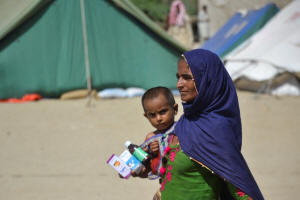Pakistan flood victims hit by disease outbreak amid stagnant water
 Send a link to a friend
Send a link to a friend
 [September 21, 2022]
By Syed Raza Hassan [September 21, 2022]
By Syed Raza Hassan
KARACHI, Pakistan (Reuters) - Skin
infections, diarrhoea and malaria are rampant in parts of Pakistan's
flood-ravaged regions, killing 324 people, authorities said on
Wednesday, adding that the situation may get out of control if required
aid doesn't arrive.
Hundreds of thousands of people displaced by the floods are living in
the open, and as floodwaters - spread over hundreds of kilometres - may
take two to six months to recede, stagnant waters have led to serious
health issues.
With Pakistan's already weak health system and lack of support,
displaced families have complained of being forced to drink and cook
with disease-ridden water.
"We know it can sicken us, but what to do, we have to drink it to stay
alive," flood victim Ghulam Rasool told local Geo News TV as he stood
near where his home was washed away in southern Pakistan.

"The aid is slow to arrive," said Dr. Farah Naureen, Mercy Corps'
country director for Pakistan after visiting several submerged regions.
"We need to work in a coordinated manner to respond to their immediate
needs," she said in a statement late Monday, prioritising clean drinking
water. Health and nutrition stand out as the most important needs of the
displaced population, she said.
The southern Sindh provincial government on Wednesday said makeshift
health facilities and mobile camps in the flooded areas had treated more
than 78,000 patients in the last 24 hours, and more than 2 million since
July 1.
[to top of second column]
|

A woman, displaced because of the
floods, carry a boy and medicines, as she takes refuge in a camp,
following rains and floods during the monsoon season in Sehwan,
Pakistan September 20, 2022. REUTERS/Stringer/File Photo
 Out of them, six died, it said.
Deaths from diseases aren't among the 1,569 people who were killed
in flash floods, including 555 children and 320 women, the country's
disaster management agency said on Wednesday.
A historic and intense monsoon dumped about three times as much rain
on Pakistan as the three-decade average, which, combined with
glacial melt, caused unprecedented flooding.
The deluge has affected nearly 33 million people in the South Asian
nation of 220 million, sweeping away homes, crops, bridges, roads
and livestock in damages estimated at $30 billion.
Officials are warning they now risk losing control of the spread of
infections in a dire situation that World Health Organization (WHO)
described as "utterly heartbreaking".
(Writing by Asif Shahzad. Editing by Gerry Doyle)
[© 2022 Thomson Reuters. All rights
reserved.] This material may not be published,
broadcast, rewritten or redistributed.
Thompson Reuters is solely responsible for this content.
 |